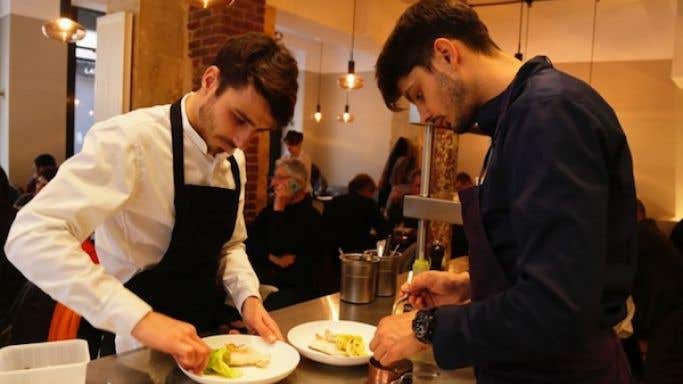A version of this article is published by the Financial Times.
On the second, unofficial day of spring precisely a fortnight ago, Jancis and I were walking in the sunshine to our lunch in Paris when suddenly she stopped and asked me, ‘Why are we going to this particular restaurant?’ To which I replied, because I had heard good things about it but also because I liked its name. We carried on walking.
A few minutes later we arrived at Restaurant Eels and what immediately greeted us left us both feeling that we had made the right decision. The open, welcoming nature of the restaurant’s interior – comfortable but not fancy – made us all (we met our FT colleague Simon Kuper for lunch) feel at home.
This restaurant starts with certain advantages. It occupies a corner site in the up-and-coming 10th arrondissement with large windows on two sides. It has been for some time a restaurant – previously serving ‘very good couscous’, I was told – so its vital infrastructure was already in place when it reopened under its new owners nine months ago. What have been added are the warmth and the creativity of its two principal partners, chef Adrien Ferrand (left) and the restaurant manager, Félix Le Louarn (right in the picture above of the pass).
Le Louarn is naturally the first person to greet you although such is the restaurant’s layout that it is impossible not to notice the chef’s smiling face shortly afterwards. Le Louarn steps out from behind the counter that runs in front of the open kitchen and guides you to your table.
As I sat down, facing the kitchen, my immediate thought was, why are all restaurants not designed more like this? Little has been spent on unnecessary artwork. The brickwork has been left exposed, as have several attractively distressed cast-iron stanchions. Ferrand and Le Louarn’s entire budget (€100,000) for the conversion has been spent where it can have the most benefit, on the kitchen.
Ferrand is stationed In front of the kitchen and as I watched him I could not help thinking of my encounter with a leading dim sum chef in Hong Kong. He had explained how his team of chefs passed their dishes to him as they were ready, and his job was to finish them and to send them out in the correct order.
This was precisely Ferrand’s role here. The cooking of the raw ingredients is executed by four, obviously talented, chefs in the kitchen, who are partially hidden from the customers but whose torsos can be viewed, hard at work, through a window by those en route to and from the toilettes.
They pass the half-finished dishes through the opening to Ferrand and he does the final assembly, wiping the plates clean before they are served, adding to each plate its particular sauce and accompaniments before he calls ‘Service’, and the dishes are taken away by Le Louarn and his team.
The reference to ‘eels’ comes from Ferrand’s fascination (one that I share) with these extraordinary sea creatures and the fact that the word in English is so much easier to say than the French anguille. A brief description of the fish, an individual that does not contain any rigidity in any part of its body, is on the back of the menu.
The menu is fashionably short: four starters, four main courses and then three desserts plus a selection of cheeses. One of the first or one of the main courses is invariably eel – so I was happy.
But on this occasion I wish that I had read Eels’ menu more like a woman and less like a man. My wife, whose theory this is, believes that men read menus as they are written, from left to right, invariably selecting the main ingredient, whereas many women read a menu from right to left, picking out the vegetable, salad, the sauce or the herb accompaniment. Here it was definitely the accompanying ingredients, albeit allied closely to the main one, which made this meal so outstanding.
It was the combination of beetroot and cranberry, not two obvious bedfellows, which contributed to the glorious pink and purple topping to my smoked eel. With the added acidity of apple and a hint of crunch from the addition of hazelnuts, this was a stunning dish. The other starter, grilled white asparagus topped with melted Scamorza cheese and a vinaigrette of bergamot, was just as successful and well conceived. All our plates were wiped clean for a second time, with our (superior) bread.
As this was lunchtime, we got no further than the first page of their wine list that offers, by the standards of this city, a broad and keenly priced range of wines by the glass. An unexpected dry German Riesling 2016 from Peter Jakob Kühn was €7 a glass, the outstanding 2016 Anjou from Château Soucherie served from a magnum was €8 while the four reds included the innovative Catalan Le Soula 2011 for €9.
With these we revelled in main courses whose flavours were as intense as the starters: a fillet of trout, served characteristically but not overly pink, with green asparagus and a bouillabaisse sauce, and a much richer, deboned, grilled quail, stuffed with foie gras, and lightened by fresh peas and baby broad beans – all with beautifully judged accompanying seasonings and textures.
For €204.50, including six glasses of wine plus a couple of desserts, my meal at Restaurant Eels for three delivered everything I look for in a meal in any restaurant anywhere – the kind of hospitality I would expect from someone in their own home combined with ultra-professional cooking of essentially straightforward ingredients. Particularly if, like me, you enjoy eels.
Restaurant Eels 27 rue d’Hauteville, 75010 Paris, France; tel +33 (0)1 42 28 80 20

